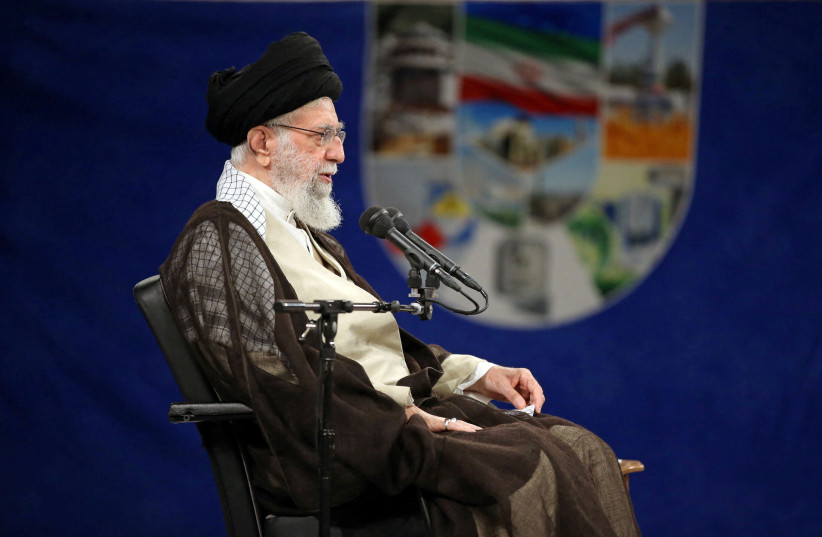There are some real signs that a partial “less for less” nuclear deal could be back in serious consideration between Iran and the West.
Such a deal would mean some partial, but not full, nuclear concessions by the Islamic Republic, in exchange for some partial, but not full, sanctions relief by the West.
Top Israeli officials have been sounding the alarm louder and more often (if still not as loud as they did against the 2015 JCPOA deal), which suggests they are worried about an agreement.
The US has been using Oman again as a go-between, a tactic which was crucial at various points for its reaching the JCPOA. But more importantly, there are reports that US and Iranian negotiators are talking with each other directly and repeatedly for the first time since the Trump administration pulled out of the JCPOA in 2018.
After all of that, the most critical indicator of all came on Sunday from Iranian Supreme Leader Ayatollah Ali Khamenei, who, after years of lambasting both the Trump and Biden administrations, said, there is “nothing wrong” with cutting a deal with the West.

This is the man who over and over again has spoken about the West as untrustworthy and as the consummate betrayer, who no one can rely on.
Many times when Iranian negotiators were making optimistic sounds about a deal being on the verge of being sealed, one negative public statement by the supreme leader shut everything down.
There have been a few other rare times where Khamenei has said positive statements about a deal with the West, and at least a few of them led to deals or interim deals.
If this “less for less” deal happens, what would it look like and mean?
A less for less Iran nuclear deal: Why is Israel still afraid?
The concept is not new.
It was attempted repeatedly for around a decade in the 2000s decade and a partial less for less deal in 2013 was what created space for the JCPOA in 2015.
After Trump exited the JCPOA in 2018, it was dallied to Iran in 2019 by European countries, by the Biden administration in the fall of 2021 and early 2022.
It has come back periodically since negotiations broke down in September 2022.
From the US perspective, Iran is nowhere near being able to field an intercontinental ballistic missile that could hit the US, so all of the nuclear issue is general and theoretical.
In that case, it mainly wants stability and to delay any threat from Tehran, even if it does not have a clear foolproof solution for preventing Khamenei from getting a nuclear bomb at some later point down the road.
This is not the Israeli perspective.
Jerusalem has been in range of Iran’s medium-range ballistic missiles since the mid-1990s, making a nuclear weapon an immediate potential existential threat.
That is not to mention that Iran’s proxies are constantly fighting or building up forces for fighting Israel, whereas the US is mostly an ocean away (occasionally some of its military forces in the Middle East get bothered by Iranian proxies.)
And the Jewish state is even more upset with the current “less for less” deal being discussed.
In 2019 and 2021, “less for less” meant a partial return to the nuclear deal, such as shipping out significant volumes of enriched uranium, in exchange for partial sanctions relief. At some point, it may be also meant at least detaching advanced centrifuges which enrich uranium at higher speeds than older Iranian models.
Now less for less reportedly means all the uranium gets to stay, all the advanced centrifuges get to stay and all Tehran needs to do is pause additional enrichment at the high 60% level.
Many Israeli security experts say this is useless because it means Khamenei gets to keep his around-five almost nuclear weapons on the threshold.
At the same time, he would get tons of additional new funds to invest in the nuclear program and terror.
On the positive side, if Iran follows the deal, Jerusalem and Washington at least buy around two-and-a-half years of Khamenei not breaking out into a nuclear weapon.
The two-and-a-half years relates to the JCPOA provisions which provide that in October 2025, the ability of the UN Security Council to use the global sanctions snapback expires and some of the limits on Iran’s centrifuges expire. This could make it much easier for Iran to break out into a nuclear weapon at that point, even if technically there are nuclear limits on it until 2030.
Israel is also worried that if the Islamic Republic tried to sneak out to a nuclear bomb, that once there is even a partial deal with the West, it will lose the legitimacy to launch a preemptive strike.
From Israel’s perspective, since the Mossad seized Iran’s nuclear secrets in 2018, it had a much freer hand in attacking Khamenei’s nuclear facilities whether overtly or covertly.
The less for less deal might reverse half a decade of a freer hand.
Then again, no one expected the Mossad to pull off the tricks it did from 2018-2022.
Israel’s air force is also much better outfitted in 2023 than probably any other time in nearly a decade to strike – if it needs to. Another two-and-a-half years will mean the delivery of some additional items, such as more midair refueling aircraft needed for an airstrike against Iran.
So less for less is not what Israel wants, but it could buy another two-and-a-half years and it does not mean Jerusalem is out of options.
